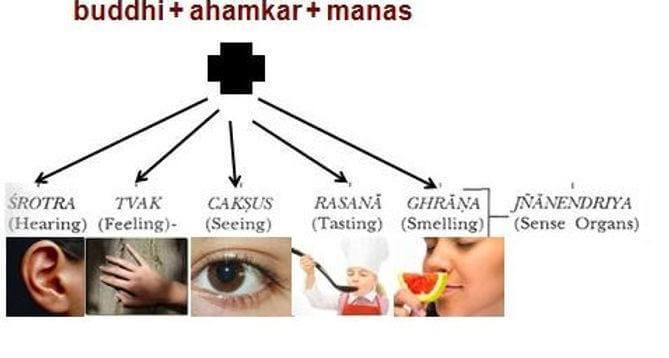Author: Randeep Singh / go to all Samkhya Karikas

Samkhya Karika 30
Yugapach chatush tayasya tu vrittih kramashashcha tasya nirdishtaa I
Drishte tathapyadrishte trayasya tat poorvika vrittih ||
Yugapach – simultaneously
Chatush tayasya – foursome
Tu – but
Vrittih – functions
Kramashah – in sequence, in succession
Cha – and
Tasya – also of
Nirdishtaa – found, are so
Drishte – the seen
Tathaapy – similarly
Adrishte – cannot be seen, subtle
Trayasya – of the three
Tat poorvika – preceded by
Vrittih – actions, functions
Samkhya Karika 30 helps answer the popular question lay men ask; whatever we cannot perceive with our five senses – consciousness – does it even exist? This karika talks about the limitations of the senses of perception – hearing, touch, seeing, tasting, smelling – in perceiving the more subtle objects like consciousness. Here we are drawing a distinction between the perception abilities of the internal organs (buddhi, ahamkara, manas) and the external organs of perception as discussed in the previous Samkhya karika.
Perception of Gross Objects is Simultaneous, Successive
The process of perception of gross objects occur when any one of the five external sense organs reads some information related to it and sends it to the internal organs for turning it into intelligent cognition. For example, when the eye (external sense organ) reads the signals from a flower, say a rose, it sends this information to the mind (manas) and the buddhi(intelligence) for interpretation from their respective angles so that the fact that it is a rose can be determined. Ahamkara (internal organ), the identity principle comes into play as it turns everything which is determined through the previous three senses (eye, buddhi, and manas) to self, or the cognition so reached is coming from the self, the perceiver, that is “I” perceive a rose.
All these four sense organs – eye, buddhi, manas, ahamkara – work simultaneously (immediate) and in the set successive order (continual) in order to establish the meaningful cognition from the signals received. Similarly, the external organ can be the ear which picks up sound signals and turns them into sensible knowledge (cognition) but simultaneously and successively working with the other three internal organs.
Thus, the data from all the other sensory faculties is known and understood. Perceiving physically along with inner faculties of knowing are vital in the process of comprehending anything.
Process of Perception by Internal organs | Samkhya Karika 30
However, for knowing the subtler objects like the consciousness the external sense faculties are of no use. Here the internal sense faculties – organs – act before the action of any external organs of perception, or their activities precede the activities of the external organs when perception of subtler objects, entities is activated.
Emotional experiences and subjective knowledge of things is internal perception rather than external. The functions of the inner sense faculties are more superior and exquisite than the external ones. The final determination or understanding of the knowledge gained is done by the buddhi which is a superior internal organ of perception. In order to know the consciousness, the subtlest of the entities, we have to depend on our internal sense organs than the external one’s.
The relation between senses and conscientiousness goes on. We have to understand this basic thing clearly; that we have to use these for our own growth. We have to reflect and contemplate on this repeatedly till we reach our destination. Just like all the instruments in a machine do their work, in the same way all the organs do their work in our body. But we ignore all this e.g. if we happen to see some good food or object, we forget the rules of the game. If the mind is quiet and all the organs are doing their work- than there is no cause of fear.
To quote and incident; there was a man, who sets up a factory, installed a machine and made all the preparations for the muhurat (an auspicious start). But on the appointed day, when the switch was turned on the machine didn’t start. An expert was called in, who started the machine by just striking it with a hammer. The “expert” demanded his fee, which the man refused citing that money can’t be paid for just striking a hammer. To which the “expert” retorted “if you had this much intelligence you wouldn’t have had to pay any money.”
This is what Samkhya tells us: if we could only understand the role of Prakriti and Purusha, life would be much easier and more wonderful.
